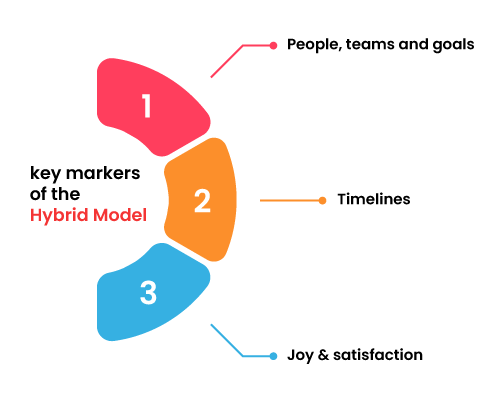
The work environment post-pandemic seems like an altered world. We have become well acquainted with terms like work from home, virtual meetings, and chat rooms. While for some, work from home has emerged as a blessing, it has also opened a whole set of challenges for the rest.
According to a survey, 98% of the employees want to work remotely at least for time. WFH culture & hybrid model has played a prominent role in running organizations worldwide. However, it has also caused inconvenience by blurring the boundaries of personal time and working hours.
Microsoft’s CEO, Satya Nadella, calls the hybrid paradox; people want the flexibility to work from anywhere, but they simultaneously crave more in-person connections.
On one hand, where work from home has eliminated the long and stressful commutes, cut down on expenses, and helped increase the quality of time with the families. It has also left people with modular identity crises; dampening the personal connections with colleagues and so on.
We all agree it gets exhausting to have your chilling room become your workspace! But the hassles of having to go to the office every day are endless too.
A list of things which has been altered in the post-pandemic era
Never-ending office commutes
The long office commutes, both to and fro alike, have dreaded and booked a lot of time off the calendar of working personnel. Work from home has been successful in deleting that time from the list.
While it is true that WFH has saved a lot of precious time for employees, it has also added another few hours of working on people’s to-do lists.
Rigid timings
The 9-5 model has always been frowned. But, come to think of it, WFH made it obvious about the rigidity of the same. If a team member finishes by 4 or sooner, they’d still sit until the clock-out time and waste precious time.
Similarly, if work has been extended, there hasn’t been an option to start late the next day! It’s frustrating how restrictive the 9-5 gig is!
But WFH, while being flexible, isn’t always fruitful. Because of its flexibility, there have been days when people have gone on to post their clock-out times to finish tasks!
Social exhaustion or lack thereof
Going to the office includes people swarming around, making conversations – every single day. Pre-COVID, the energy, and motivation of working with familiar faces were quite relevant. Surely the calm and peace-seeking souls would shatter sometimes. But working alone all day with no people around and inside the closed doors of our homes hasn’t been fulfilling either.
Stuck and struck by processes
The pandemic definitely hit processes like a truck! People who went to the office used physical paper and files or had everything manual- they were stuck. Distribution channels, sales, internal processes- chaos. And work from Home didn’t make it easy. They quickly had to adopt, and most in that scenario did it haphazardly. Take filing of receipts or sending approvals for proposals.
It gets exhausting, and people’s productivity has definitely been affected!
There are endless arguments about the hassles of only-work from the office and only WFH. It’s clear and obvious that organizations need a radical change and adopt a flexible, quality method and reinvent work culture – with a Hybrid Work Model.
Mixing It Up!
When life gives us options, mix it up for the best.
The Hybrid Model essentially is a mix of Office & WFH- duh.
But that’s not it. Organizations can’t just declare the Hybrid Model and expect things to work out, as it can end up being a mess.
The challenges that lie in making the Hybrid Model. A core change to an organization’s strategy and a lot many at operations. In reality, flexible work consists of more than sharing online tool kits, alternating workdays, or asking half the staff to come in on certain days, etc.
The Hybrid model cannot be haphazard. It requires strategic thinking about who needs to come in on what days and, most importantly, why.
Is there a client meeting scheduled on Thursday, and do we need to brainstorm in the office? Is it because numbers need to be discussed, or can it be automated?
One of the major shifts in the past year has been going fully digital but that doesn’t mean it has been the most productive or efficient. You may still be working on Excel sheets every month or missing important emails due to spam.
The Hybrid Model requires smart & intelligent decision-making. Digital process automation with logical and efficient outputs not only saves hours but helps increase productivity.
For instance, Quixy is a top-rated platform that will help you and your business achieve the results for the Hybrid Model with citizen development and no-code apps, which are nothing but app development platforms that require zero coding!
Also Read: A 10-Step Guide to Enhancing Productivity
But how do we even go about this?
Here are key markers of the Hybrid Model

1. People, teams and goals
Answer the following questions for your organization and employees.
- Which people would work best together in a physical space and what are the goals achieved?
- Can they come on the days you assign? If not, can they join remotely?
- What about individual roles, constraints, and potential to contribute? How can each resource be put together efficiently for maximum productivity?
Shared goals that lay out how the team will collaborate effectively with different resources and tools will give everyone a sense of clarity. Productivity seeks clarity.
Don’t do this manually. Create a no-code app or automate the workflow in a smart way for all of these simple tasks that determine the ideal model for you and the organization. In the end, what matters is the results achieved by adopting the model and how to best achieve them.
2. Timelines
Any project- internal or external, requires timelines. If you have decided you’d like to adopt the model in 2022, now is the time to start planning. Backtrack the tasks that need to be fulfilled by the time you open- operations, finances, everything.
You can create a systematic system of tracking all of the above with productivity tools like Quixy, Calendly, Asana, no-code applications- the possibilities are endless. Creating timesheets with simple workflows with no-code apps saves time, energy and also is fun!
Productivity is not about what you do; it’s about HOW you do it.
3. Joy & satisfaction
Yes, it is the key marker of the Hybrid Model. To have fun, embrace change and flexibility. Initiate Friday activities in the office to motivate people. Take coffee breaks and talk about weekend plans and activities.
Even recommend courses based on people’s choices. We’re adopting the Hybrid Model to experience the best of both worlds! Working from home and the office become something to look forward to.
Also read: 20 Must-have No-Code Productivity Tools to boost your Efficiency
Conclusion
The change may seem daunting. But being a crucial step towards creating an opportunity for organizations to build new workplace cultures, the Hybrid workplace Model paves not only the way to employees’ greater fulfillment but also better business growth and results.
There is no correct answer or one linear way to go about the Hybrid Model, but we hope that this sparks an idea of what is to come and also learn more about your own company and organization and foster a culture that makes the Hybrid Model the ideal scenario for humans.
To ease the transition, we recommend that you do thorough research and surveys within the organization, build a system, and automate processes that don’t necessarily need manual intervention. Apps like Quixy and Asana help achieve the simplest and the most complex workflows into quick, easy processes and lead to higher productivity within the organization.
Frequently Asked Questions (FAQ’s )
1. What legal factors should organizations consider in a Hybrid Model?
Businesses must address labor laws, data security, health standards, and equitable policies to ensure compliance and fairness for all employees.
2. How can employees maintain balance in a Hybrid Work Model?
Employees should establish work-life boundaries, set a structured routine, and create a dedicated workspace to separate professional and personal life.
3. How can businesses evaluate the success of the Hybrid Model?
Success can be assessed through employee feedback, tracking productivity improvements, analyzing retention rates, and evaluating goal achievement.
4. Does the Hybrid Work Model improve productivity?
It often boosts productivity through flexibility, though challenges like miscommunication can arise. The impact depends on proper tools and clear expectations.
5. Why is the Hybrid Work Model beneficial?
It enhances flexibility, reduces commuting time, and allows employees to better balance their personal and professional lives while increasing access to a diverse talent pool.
Subscribe
Login
Please login to comment
0 Comments
Oldest















